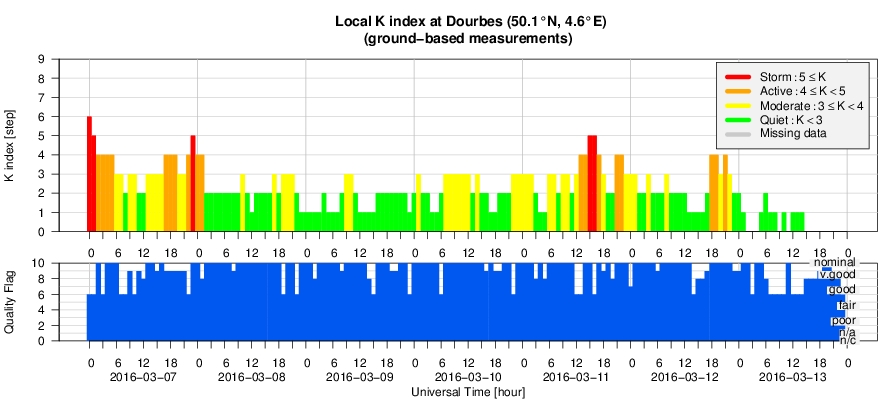- Table of Content
- 1.ESWW13 - Call ...
- 2.PROBA2 Guest I...
- 3.Review of sola...
- 4.The Internatio...
- 5.Geomagnetic Ob...
- 6.PROBA2 Observa...
- 7.Review of iono...
- 8.Future Events
2. PROBA2 Guest Investigator Program
3. Review of solar and geomagnetic activity
4. The International Sunspot Number
5. Geomagnetic Observations at Dourbes (7 Mar 2016 - 13 Mar 2016)
6. PROBA2 Observations (7 Mar 2016 - 13 Mar 2016)
7. Review of ionospheric activity (7 Mar 2016 - 13 Mar 2016)
8. Future Events
ESWW13 - Call for contributions to sessions
13th European Space Weather Week, November 2016, Belgium
*** Call for contributions to the sessions *** 1st announcement

The ESWW is the main annual event in the European Space Weather calendar. The agenda will be composed of plenary/parallel sessions, working meetings and dedicated events for service end-users. The ESWW will again adopt the central aim of bringing together the diverse groups in Europe working on different aspects of Space Weather.
ESWW13 will be held in Belgium, possible dates are November 14-18 and November 28 – December 2. We hope to announce the exact venue and dates in April.
Following an excellent response to the call for sessions, the Programme Committee is pleased to invite contributions to sessions, addressing a wide range of scientific and application related themes. Each session is split into a poster and oral part. The poster programme emphasizes discussion and interaction between people. The oral part will consist of both invited and contributed papers.
The session list and link to submit are on http://www.stce.be/esww13/program/sessions.php
Deadline for submission is June 6, 2016 included.
Happy submission!
Mauro Messerotti (Chair PC), Petra Vanlommel (Chair PC) Alexi Glover (Vice Chair PC), Ronald Van der Linden (Chair LOC)
PROBA2 Guest Investigator Program
Due to a recent surge in interest in the PROBA2 Guest Investigator program the proposal submission deadline has been extended to 2016 April 01. Those who have already submitted a proposal may re-submit their proposal if they wish to work on them more.
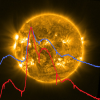
The PROBA2 team welcomes research proposals for the seventh round of its Guest Investigator program for research based on SWAP and LYRA data analysis by scientists outside the SWAP and LYRA PI-teams. We encourage in particular young post-docs and PhD students to apply, although more senior guest investigators' proposals are welcome also. In this round we anticipate funding for around six guest investigators or teams who will visit the PROBA2 Science Center at the Royal Observatory of Belgium, in Brussels, between April 2016 and December 2016.
Selected proposers will be invited to spend a few weeks with the PI teams to obtain expert knowledge on the instruments, to participate in the daily commanding of the SWAP and LYRA instruments according to the needs of their data analysis proposal, and to conduct their research. Guest investigators may be reimbursed for travel, accommodation and living expenses up to a maximum of 5000 euro. Limited support to present the results at an international conference (during the visit at P2SC) can also be considered.
During the selection process, special consideration will be given to young scientists and PhD students, collaborative research teams with members from more than one research institute (funding above the 5000 euro level may be approved for such teams), and to proposals addressing research topics to which SWAP and LYRA are particularly well-suited.
More details about the application process can be found here: http://proba2.oma.be/SeventhGICall
or by emailing swap_lyra@oma.be
Dr Matthew J West
PROBA2 Technical Coordinator and Liaison Scientist
Review of solar and geomagnetic activity
Solar non-Activity
Solar activity was low during the week, only four C-class flares were observed. No Earth-directed CMEs were detected.
Geomagnetic Activity
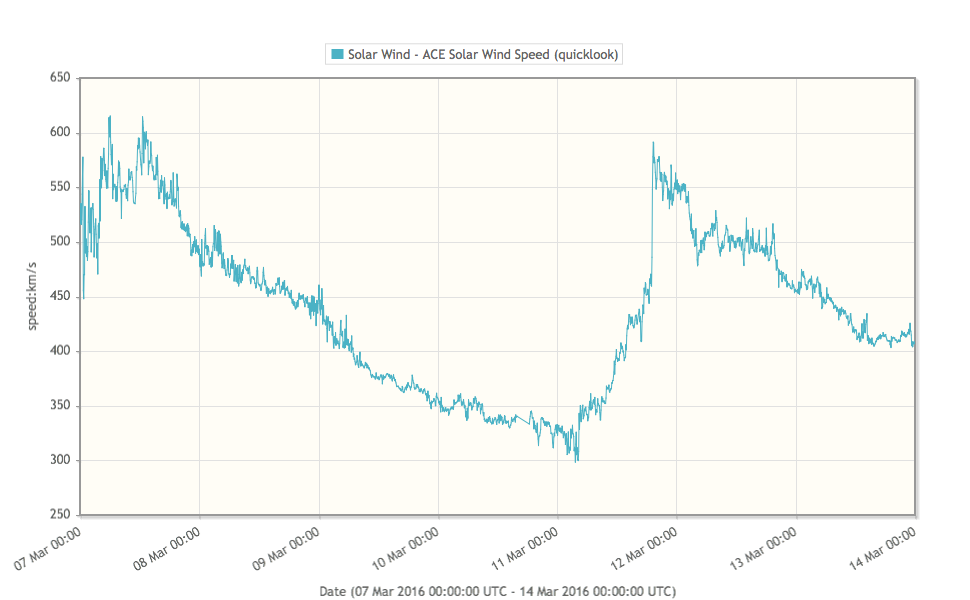
The week started with the Earth inside a high speed stream that arrived during the previous week. As a consequence, minor storm conditions (Kp = 5, Kdourbes = 5) were recorded on March 7 (Monday). Another high speed speed stream arrived on March 11 (Friday and produced major storm at planetary levels (Kp =6) and minor storms locally (KDourbes = 5).
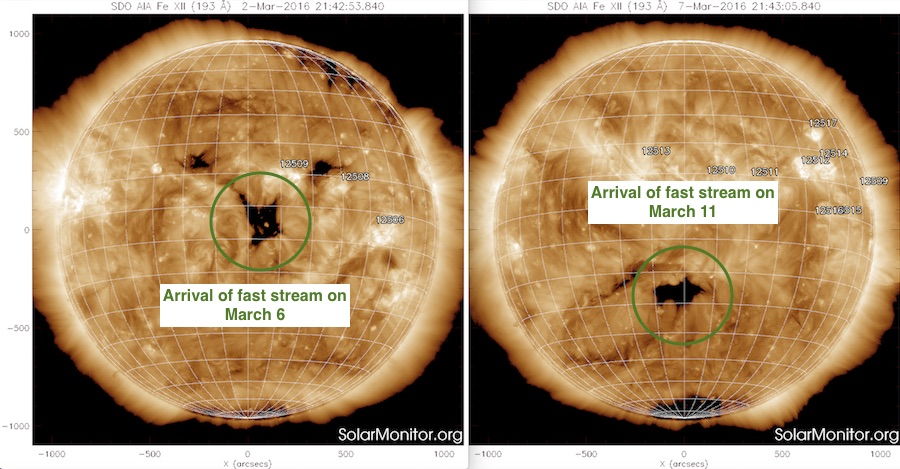
On the above SDO pictures you see that the coronal holes responsible for the geomagnetic disturbances are relatively small. Since we are approaching a solar minimum, coronal holes, even if they are small, will become the main source of geomagnetic disturbances. The season of coronal holes has definitely started.
The International Sunspot Number
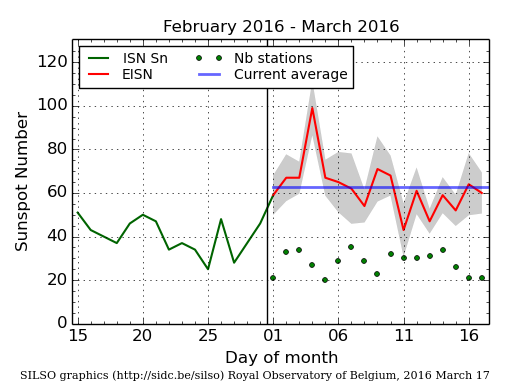
The daily Estimated International Sunspot Number (EISN, red curve with shaded error) derived by a simplified method from real-time data from the worldwide SILSO network. It extends the official Sunspot Number from the full processing of the preceding month (green line). The plot shows the last 30 days (about one solar rotation). The horizontal blue line shows the current monthly average, while the green dots give the number of stations included in the calculation of the EISN for each day.
PROBA2 Observations (7 Mar 2016 - 13 Mar 2016)
Solar Activity
Solar flare activity fluctuated between very low and low during the week.
In order to view the activity of this week in more detail, we suggest to go to the following website from which all the daily (normal and difference) movies can be accessed:
http://proba2.oma.be/ssa
This page also lists the recorded flaring events.
A weekly overview movie can be found here (SWAP week 311).
http://proba2.oma.be/swap/data/mpg/movies/weekly_movies/weekly_movie_2016_03_07.mp4
Details about some of this week’s events, can be found further below.
Tuesday Mar 08
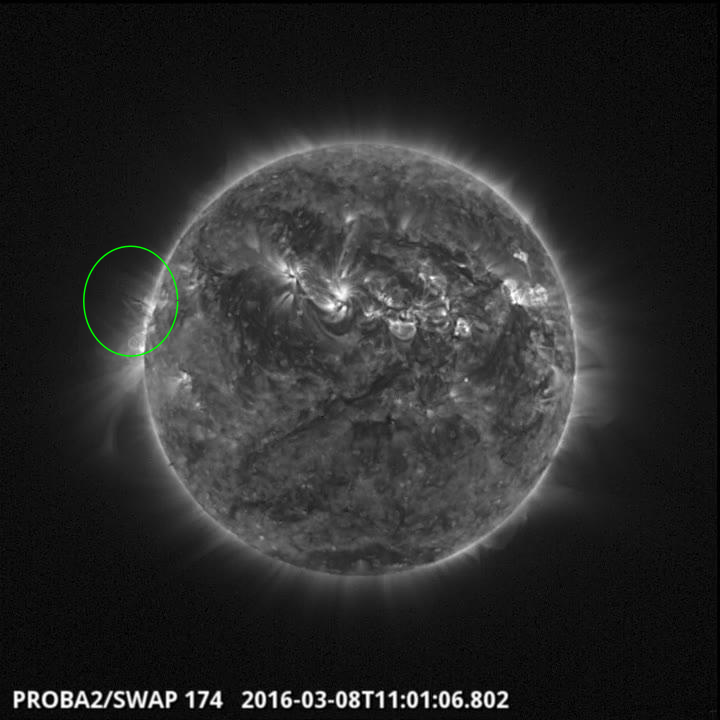
An eruption was observed by SWAP on the east limb at 11:01 UT on 2016 Mar 08
Find a movie of the event here (SWAP movie)
http://proba2.oma.be/swap/data/mpg/movies/20160308_swap_movie.mp4
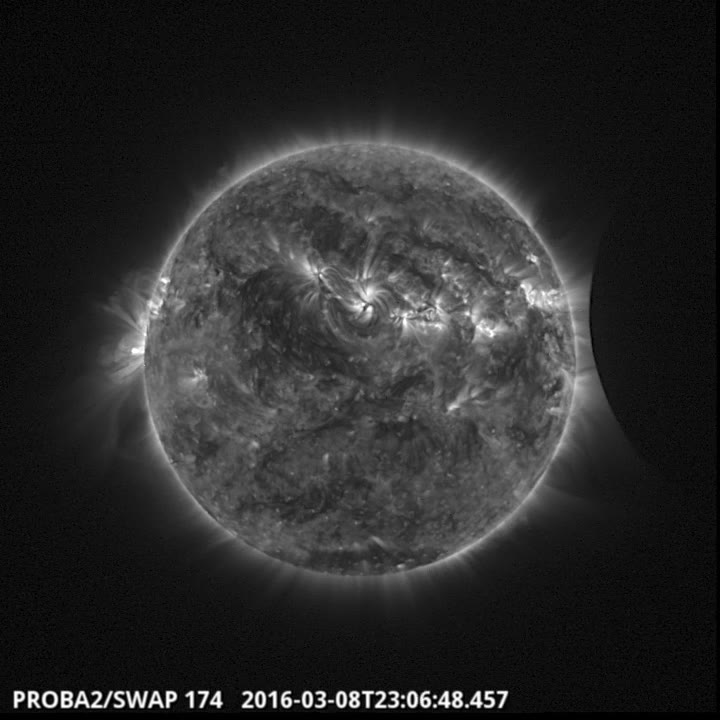
The moon passing inside SWAP’s field of view at 23:06 UT on 2016 Mar 08
Find a movie of the event here (SWAP movie)
http://proba2.oma.be/swap/data/mpg/movies/20160308_swap_movie.mp4
Wednesday Mar 09
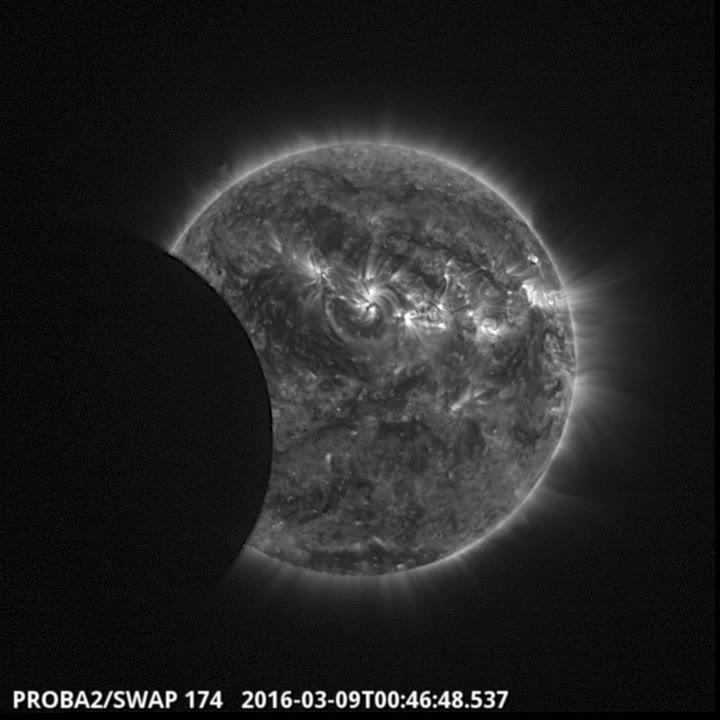
The moon passing inside SWAP’s field of view at 00:46 UT on 2016 Mar 09
Find a movie of the event here (SWAP movie)
http://proba2.oma.be/swap/data/mpg/movies/20160309_swap_movie.mp4
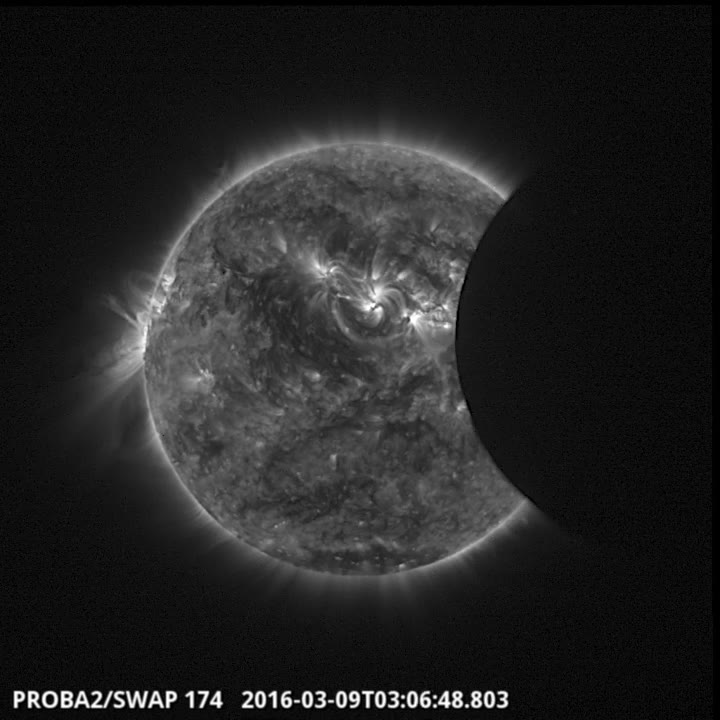
The moon passing inside SWAP’s field of view at 03:06 UT on 2016 Mar 09
Find a movie of the event here (SWAP movie)
http://proba2.oma.be/swap/data/mpg/movies/20160309_swap_movie.mp4
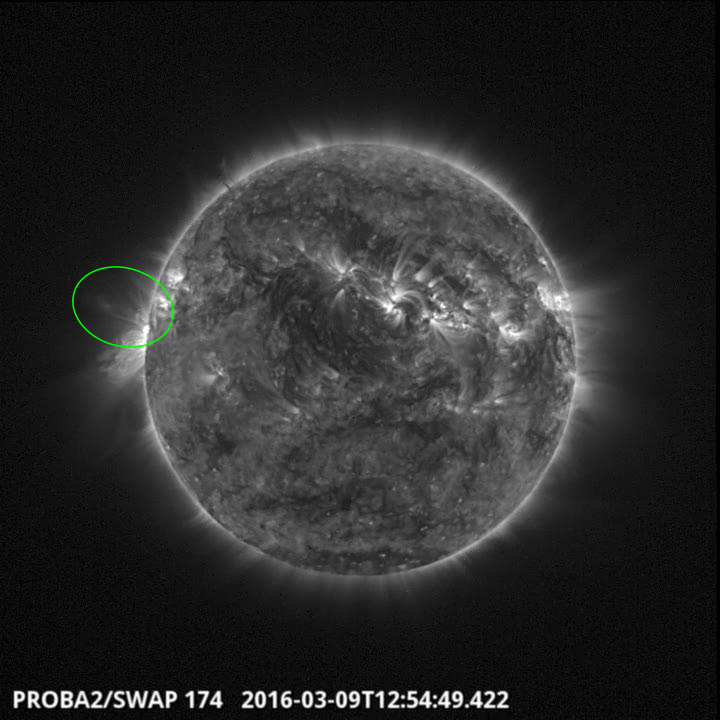
An eruption was observed by SWAP on the east limb at 12:54 UT on 2016 Mar 09
Find a movie of the event here (SWAP movie)
http://proba2.oma.be/swap/data/mpg/movies/20160309_swap_movie.mp4
Thursday Mar 10
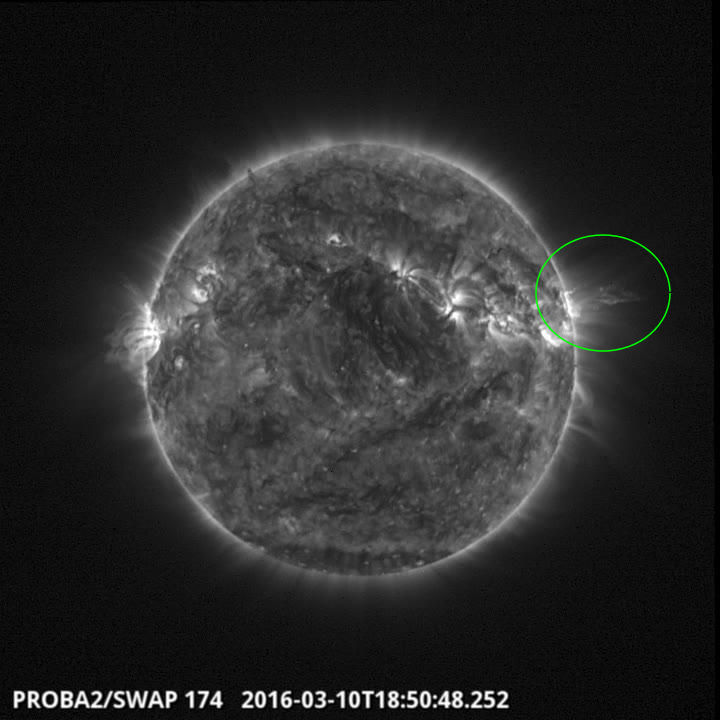
An eruption was observed by SWAP on the west limb at 18:50 UT on 2016 Mar 10
Find a movie of the event here (SWAP movie)
http://proba2.oma.be/swap/data/mpg/movies/20160310_swap_movie.mp4
Sunday Mar 13
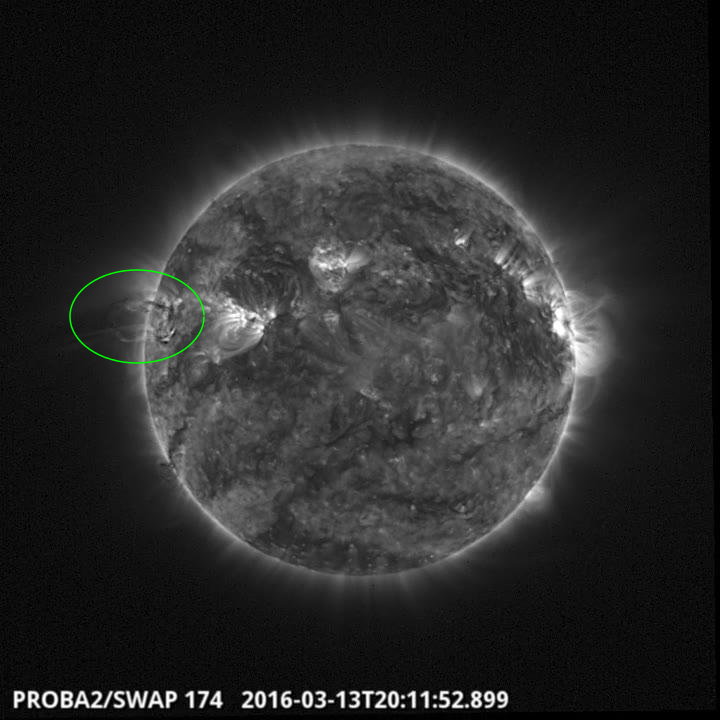
A confined eruption was observed by SWAP on the east limb at 20:11 UT on 2016 Mar 13
Find a movie of the event here (SWAP movie)
http://proba2.oma.be/swap/data/mpg/movies/20160313_swap_movie.mp4
Review of ionospheric activity (7 Mar 2016 - 13 Mar 2016)
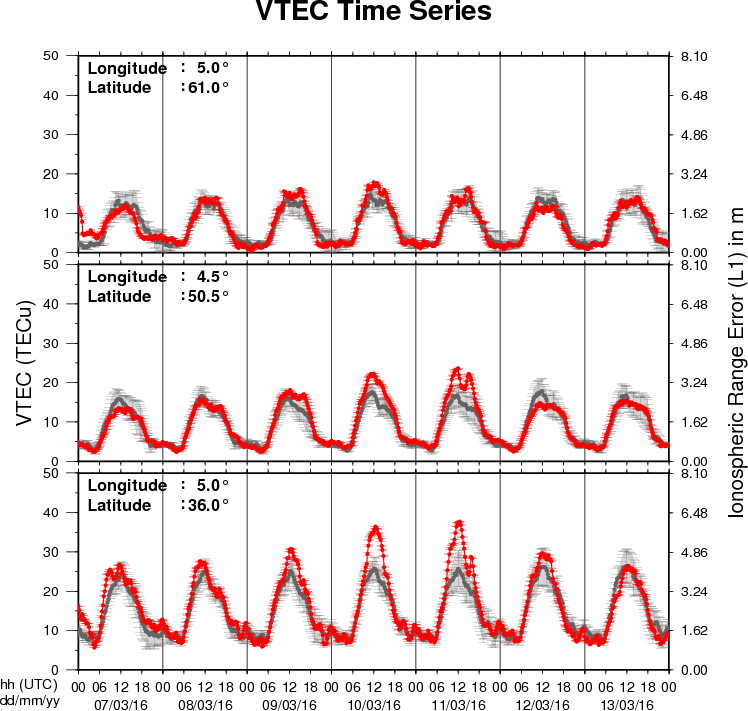
The figure shows the time evolution of the Vertical Total Electron Content (VTEC) (in red) during the last week at three locations:
a) in the northern part of Europe(N61°, 5°E)
b) above Brussels(N50.5°, 4.5°E)
c) in the southern part of Europe(N36°, 5°E)
This figure also shows (in grey) the normal ionospheric behaviour expected based on the median VTEC from the 15 previous days.
The VTEC is expressed in TECu (with TECu=10^16 electrons per square meter) and is directly related to the signal propagation delay due to the ionosphere (in figure: delay on GPS L1 frequency).
The Sun's radiation ionizes the Earth's upper atmosphere, the ionosphere, located from about 60km to 1000km above the Earth's surface.The ionization process in the ionosphere produces ions and free electrons. These electrons perturb the propagation of the GNSS (Global Navigation Satellite System) signals by inducing a so-called ionospheric delay.
See http://stce.be/newsletter/GNSS_final.pdf for some more explanations ; for detailed information, see http://gnss.be/ionosphere_tutorial.php
Future Events
For more details, see http://www.spaceweather.eu/en/event/future
The Scientific Foundation of Space Weather
Start : 2016-06-27 - End : 2016-07-01
Website:
http://www.issibern.ch/program/workshops.html
